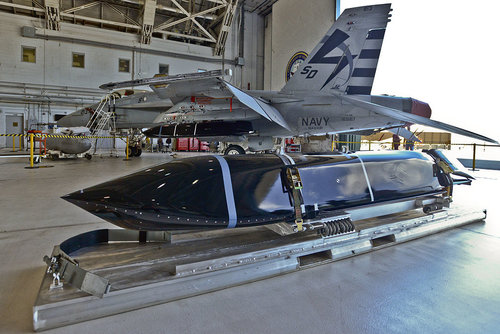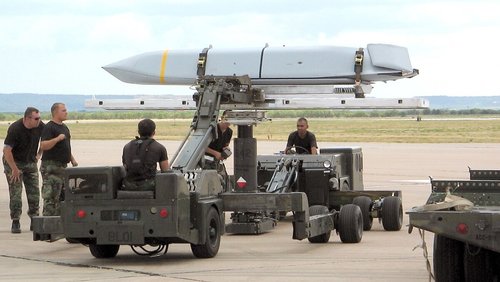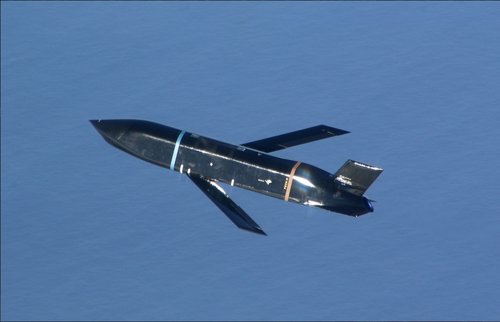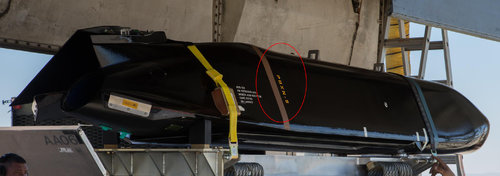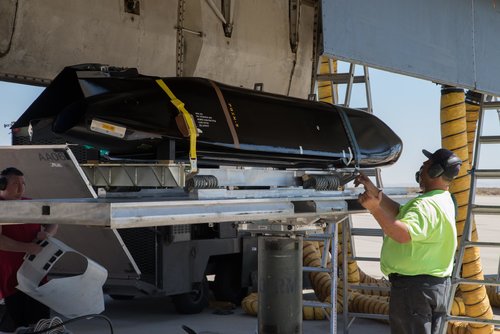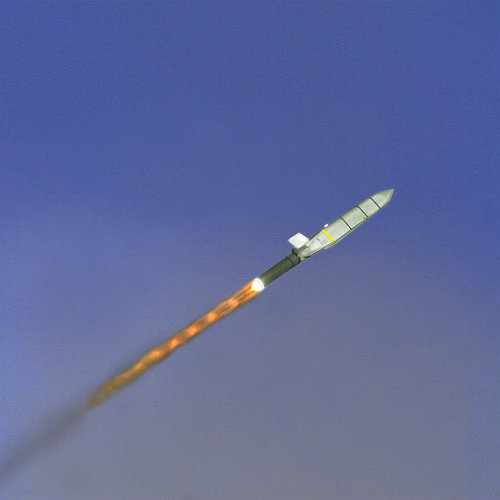You are using an out of date browser. It may not display this or other websites correctly.
You should upgrade or use an alternative browser.
You should upgrade or use an alternative browser.
DARPA Long Range Anti-ship Missile (LRASM)
- Thread starter bobbymike
- Start date
- Joined
- 16 April 2008
- Messages
- 9,605
- Reaction score
- 14,501
In addition, both China and South Korea have VLS systems with cells even larger than the US Mk57 cells.
Larger than Mk57? Haven't seen those.
- Joined
- 3 June 2011
- Messages
- 18,337
- Reaction score
- 12,239
In addition, both China and South Korea have VLS systems with cells even larger than the US Mk57 cells.
Larger than Mk57? Haven't seen those.
China's Type 055 cruiser has them. Interior envelope of canister: 33.5 x 33.5 x 354.3
SKs KVLS-II: 29.5 x 29.5 x 309
The South Korean KVLS has larger cells than the Mk41. The KVLS-II larger still.
AkelaFreedom
ACCESS: Secret
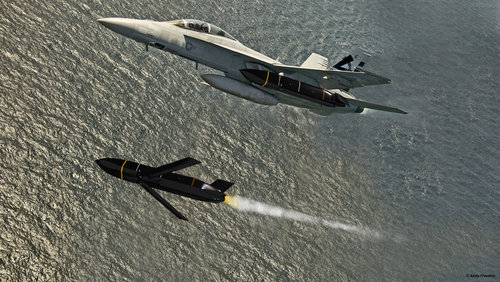
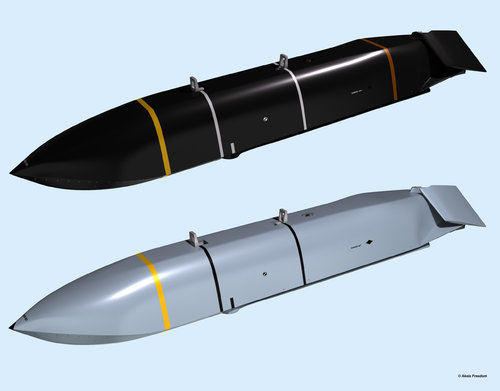
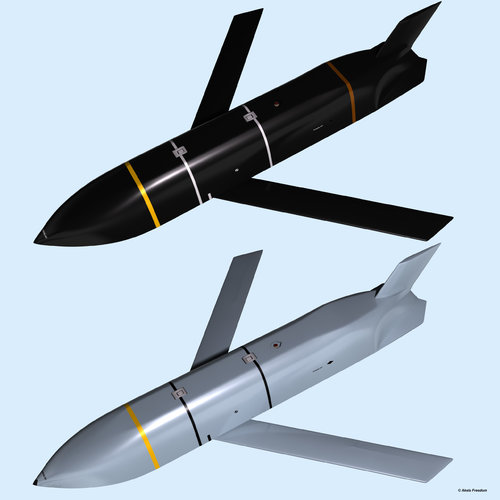
AGM-158C and AGM-158A. I think it will be interesting. The full set can be seen here - https://www.artstation.com/artwork/4bLWz1
AkelaFreedom
ACCESS: Secret
The AGM-158C test sample is precisely so painted.That should probably go in the User Art section, not here. Also, they don't paint them black. That's just the bare carbon.
- Joined
- 3 June 2011
- Messages
- 18,337
- Reaction score
- 12,239
This thing? That's bare carbon, not paint.The AGM-158C test sample is precisely so painted.That should probably go in the User Art section, not here. Also, they don't paint them black. That's just the bare carbon.
Attachments
AkelaFreedom
ACCESS: Secret
Explain why covering bare carbon? And even if this is so, then what is wrong with the display of this material in the model?This thing? That's bare carbon, not paint.
AkelaFreedom
ACCESS: Secret
What self-superiority does not allow you to answer normally? I really do not know why bare carbon is coated, and I ask you about it. I have no information about this. Are you not even able to explain?Explain why covering bare carbon? And even if this is so, then what is wrong with the display of this material in the model?This thing? That's bare carbon, not paint.
View attachment 621828
- Joined
- 3 June 2011
- Messages
- 18,337
- Reaction score
- 12,239
I really do not know why bare carbon is coated, and I ask you about it. I have no information about this.
The AGM-158C test sample is precisely so painted.
AkelaFreedom
ACCESS: Secret
And where is the contradiction in my statements? The only photographs of the AGM-158C are in black. Photos from the tests. It is clear that after adoption, they will most likely be standard gray. But in the coloring of the model, I reflected exactly the kind that I see in the photo. I’m not a chemist by education and I don’t know if this is the original color of the plastic from which the body is assembled, or is it some kind of coating (as you say carbon). Well, let's say I didn’t put it right - this is not painting but the application of a carbon coating or this is some form of plastic which includes a carbon coating. My fault maybe. But I still don’t understand how this does not correspond to the appearance of the model that I created and painted in black? What am I missing then?I really do not know why bare carbon is coated, and I ask you about it. I have no information about this.The AGM-158C test sample is precisely so painted.
- Joined
- 3 June 2011
- Messages
- 18,337
- Reaction score
- 12,239
Basically what you're seeing is the tool surface of the resin matrix. It's translucent so the black of the carbon fiber dominates the color. Also you have stripes colored for a live weapon, which would never be bare. The blue stripe on the weapon in the actual picture signify dummy/training round. IIRC blue for training, yellow for warhead, brown for rocket motor. Not sure what the significance of the white stripes are.And where is the contradiction in my statements? The only photographs of the AGM-158C are in black. Photos from the tests. It is clear that after adoption, they will most likely be standard gray. But in the coloring of the model, I reflected exactly the kind that I see in the photo. I’m not a chemist by education and I don’t know if this is the original color of the plastic from which the body is assembled, or is it some kind of coating (as you say carbon). Well, let's say I didn’t put it right - this is not painting but the application of a carbon coating or this is some form of plastic which includes a carbon coating. My fault maybe. But I still don’t understand how this does not correspond to the appearance of the model that I created and painted in black? What am I missing then?I really do not know why bare carbon is coated, and I ask you about it. I have no information about this.The AGM-158C test sample is precisely so painted.
AkelaFreedom
ACCESS: Secret
Thanks for the answer. Yes, I am familiar with the color code of the stripes. But why not assume that a real warhead was installed for testing. Then, after all, according to the rules, a yellow stripe should be applied.Basically what you're seeing is the tool surface of the resin matrix. It's translucent so the black of the carbon fiber dominates the color. Also you have stripes colored for a live weapon, which would never be bare. The blue stripe on the weapon in the actual picture signify dummy/training round. IIRC blue for training, yellow for warhead, brown for rocket motor. Not sure what the significance of the white stripes are.
- Joined
- 3 June 2011
- Messages
- 18,337
- Reaction score
- 12,239
Thanks for the answer. Yes, I am familiar with the color code of the stripes. But why not assume that a real warhead was installed for testing. Then, after all, according to the rules, a yellow stripe should be applied.Basically what you're seeing is the tool surface of the resin matrix. It's translucent so the black of the carbon fiber dominates the color. Also you have stripes colored for a live weapon, which would never be bare. The blue stripe on the weapon in the actual picture signify dummy/training round. IIRC blue for training, yellow for warhead, brown for rocket motor. Not sure what the significance of the white stripes are.
Not sure what the hell is going on here:
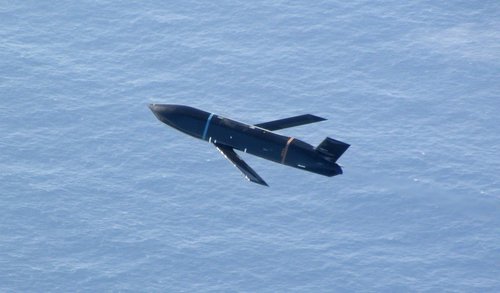
Attachments
Last edited:
AkelaFreedom
ACCESS: Secret
All is correct. According to MIL-STD-709C, Brown means - "Identifies low explosive items or components or indicates the presence of a low explosive; such rocket propellant." In our case, this is the presence of rocket propellant. The fact that this test without a warhead tells us the first blue line. But why there is no brown strip on the AGM-158A / B is another question.Because that's not what they do. Yellow stripe is painted. Blue stripe is training with no warhead.
Not sure what the hell is going on here:
View attachment 621830
AkelaFreedom
ACCESS: Secret
AkelaFreedom
ACCESS: Secret
- Joined
- 3 June 2011
- Messages
- 18,337
- Reaction score
- 12,239
Edwards AFB site. Hmm

"“The missile navigated through all planned waypoints, transitioned to mid-course guidance and flew toward the moving maritime target using inputs from the onboard multimodal sensor,” read a release from the company.
“The missile then descended to low altitude for final approach to target area, positively identified and impacted the target.”"
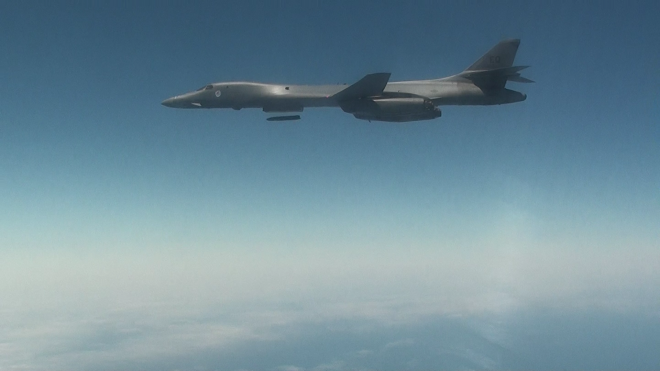
 news.usni.org
news.usni.org
Quick learning, ‘deployed mentality’ lead to LRASM’s successful launch
No test at Edwards can be considered simple, but when you add in numerous organizations with their own language and procedures, along with a test aircraft with engine problems, then that makes
www.edwards.af.mil
"“The missile navigated through all planned waypoints, transitioned to mid-course guidance and flew toward the moving maritime target using inputs from the onboard multimodal sensor,” read a release from the company.
“The missile then descended to low altitude for final approach to target area, positively identified and impacted the target.”"

LRASM Succeeds in At Sea B-1B Bomber Tactical Launch Test - USNI News
The Navy’s next-generation anti-ship missile scored in its first tactical configuration test launching from a B-1B Lancer bomber, Lockheed Martin announced on Friday. The West Coast test had the Lancer launch a Long-Range Anti-Ship Missile (LRASM) to hit a moving maritime target operating in the...
AkelaFreedom
ACCESS: Secret
- Joined
- 21 April 2009
- Messages
- 13,756
- Reaction score
- 7,696
LRASM Achieved EOC with U.S. Navy’s F/A-18E/F Super Hornet - Naval News
The next generation Long-Range Anti-Ship Missiles (LRASM) achieved early operational capability (EOC) with the F/A-18E/F in November, Naval News learned from NAVAIR, bringing new capabilities to U.S. Naval Air Forces.
- Joined
- 21 April 2009
- Messages
- 13,756
- Reaction score
- 7,696
- Joined
- 21 April 2009
- Messages
- 13,756
- Reaction score
- 7,696
Lawmakers diverge on Air Force plans for anti-ship missile purchases
As the Air Force looks to ramp up production of anti-ship missiles, House appropriators argue proposed buys in fiscal year 2021 are premature and suggest zeroing out funding, while Senate authorizers recommend accelerating purchases to meet growing needs in the Indo-Pacific region
As the Air Force looks to ramp up production of anti-ship missiles, House appropriators argue proposed buys in fiscal year 2021 are premature and suggest zeroing out funding, while Senate authorizers recommend accelerating purchases to meet growing needs in the Indo-Pacific region
- Joined
- 3 June 2011
- Messages
- 18,337
- Reaction score
- 12,239
Lawmakers diverge on Air Force plans for anti-ship missile purchases
As the Air Force looks to ramp up production of anti-ship missiles, House appropriators argue proposed buys in fiscal year 2021 are premature and suggest zeroing out funding, while Senate authorizers recommend accelerating purchases to meet growing needs in the Indo-Pacific region
Oh look, the House wanting to gut another program. I. Am. Shocked. LRASM should be ramped up ASAP. You can't just decide one day that you need them and presto, there's a thousand of them in the inventory. Production capacity is finite and it's going to take time to build a useful inventory of them as it is.
- Joined
- 18 May 2019
- Messages
- 640
- Reaction score
- 1,673
The US Air Force (USAF) is conducting market research into kinetic weapons capable of engaging and defeating maritime surface vessels, according to a 24 July request for information (RFI) posted on the federal contracting website beta.sam.gov.
No further details were available with the public version of the RFI, which had a version classified secret by the Air Force Life Cycle Management Center (AFLCMC) armament systems development division. USAF spokesperson Ilka Cole said on 10 August that while the specific capabilities sought are classified, the service seeks information on any kinetic weapon capable of engaging and defeating maritime surface vessels.
The US Air Force, in a recent RFI, is looking for a maritime strike weapon that could be an alternative to making a longer-range version of the LRASM, according to an expert. (Getty Images)
The US Air Force, in a recent RFI, is looking for a maritime strike weapon that could be an alternative to making a longer-range version of the LRASM, according to an expert. (Getty Images)
An expert believes that this RFI is the USAF’s effort to capture weapons compatible with the Lockheed Martin F-35 Lightning II Joint Strike Fighter (JSF) that are not the Lockheed Martin AGM-158C Long Range Anti-Ship Missile (LRASM) nor the Raytheon-Kongsberg Defense Systems Joint Strike Missile (JSM) air-launched anti-ship weapon being developed for the F-35. Bryan Clark, senior fellow at the Hudson Institute think tank in Washington, DC, told Janes on 31 July that the LRASM will probably not be compatible with the F-35 as the stakeholders have not been able to integrate it on to the aircraft for internal carriage due to the weapon’s large size.
Lockheed Martin spokesman Brett Ashworth said on 12 August that the company is investing in F-35 integration efforts for LRASM and the AGM-158B Joint Air to Surface Standoff Missile-Extended Range (JASSM-ER). He said there is operator interest in both weapons and the company is working to ensure outstanding weapon stand-off and effects.
 www.janes.com
www.janes.com
No further details were available with the public version of the RFI, which had a version classified secret by the Air Force Life Cycle Management Center (AFLCMC) armament systems development division. USAF spokesperson Ilka Cole said on 10 August that while the specific capabilities sought are classified, the service seeks information on any kinetic weapon capable of engaging and defeating maritime surface vessels.
The US Air Force, in a recent RFI, is looking for a maritime strike weapon that could be an alternative to making a longer-range version of the LRASM, according to an expert. (Getty Images)
The US Air Force, in a recent RFI, is looking for a maritime strike weapon that could be an alternative to making a longer-range version of the LRASM, according to an expert. (Getty Images)
An expert believes that this RFI is the USAF’s effort to capture weapons compatible with the Lockheed Martin F-35 Lightning II Joint Strike Fighter (JSF) that are not the Lockheed Martin AGM-158C Long Range Anti-Ship Missile (LRASM) nor the Raytheon-Kongsberg Defense Systems Joint Strike Missile (JSM) air-launched anti-ship weapon being developed for the F-35. Bryan Clark, senior fellow at the Hudson Institute think tank in Washington, DC, told Janes on 31 July that the LRASM will probably not be compatible with the F-35 as the stakeholders have not been able to integrate it on to the aircraft for internal carriage due to the weapon’s large size.
Lockheed Martin spokesman Brett Ashworth said on 12 August that the company is investing in F-35 integration efforts for LRASM and the AGM-158B Joint Air to Surface Standoff Missile-Extended Range (JASSM-ER). He said there is operator interest in both weapons and the company is working to ensure outstanding weapon stand-off and effects.
Update: US Air Force seeks information on maritime strike weapon
The US Air Force (USAF) is conducting market research into kinetic weapons capable of engaging and defeating maritime surface vessels, according to a 24 July request for...
bring_it_on
I really should change my personal text
- Joined
- 4 July 2013
- Messages
- 3,669
- Reaction score
- 3,831
An expert believes that this RFI is the USAF’s effort to capture weapons compatible with the Lockheed Martin F-35 Lightning II Joint Strike Fighter (JSF) that are not the Lockheed Martin AGM-158C Long Range Anti-Ship Missile (LRASM) nor the Raytheon-Kongsberg Defense Systems Joint Strike Missile (JSM) air-launched anti-ship weapon being developed for the F-35.
If that is actually the case, then why not just spell out "JSOW-ER" ? Unless of course they want to consider an AARGM-ER variant which wouldn't be out of the realm of possibility (the AARGM has the ability to find and target ships).
- Joined
- 16 April 2008
- Messages
- 9,605
- Reaction score
- 14,501
An expert believes that this RFI is the USAF’s effort to capture weapons compatible with the Lockheed Martin F-35 Lightning II Joint Strike Fighter (JSF) that are not the Lockheed Martin AGM-158C Long Range Anti-Ship Missile (LRASM) nor the Raytheon-Kongsberg Defense Systems Joint Strike Missile (JSM) air-launched anti-ship weapon being developed for the F-35.
If that is actually the case, then why not just spell out "JSOW-ER" ? Unless of course they want to consider an AARGM-ER variant which wouldn't be out of the realm of possibility (the AARGM has the ability to find and target ships).
Kinetic here is a confusing word. Do they just mean explosive as opposed to non-kinetic things like electronic attack? Or do they mean kinetic as in kinetic kill vehicles, which means something in the hypersonic regime?
If the former, what's wrong with competing JSM and JSOW-ER?
bring_it_on
I really should change my personal text
- Joined
- 4 July 2013
- Messages
- 3,669
- Reaction score
- 3,831
The JSOW-ER is already going to be in the US Navy inventory and go through the entire dev and ops testing with the F-35C so it would likely be a more cost-effective platfrom from a long term inventory and sustainment perspective. Unless there is a huge performance gap between the JSOW-ER and JSM, there is probably merit in retaining commonality with the Navy weapon just like the AF is doing with the SiAW.
marauder2048
"I should really just relax"
- Joined
- 19 November 2013
- Messages
- 3,157
- Reaction score
- 926
Kinetic here is a confusing word. Do they just mean explosive as opposed to non-kinetic things like electronic attack?
I take it to mean kinetic as in blast/frag, penetrating, shape-charge vs. EW or DEWs.
The JSOW-ER is already going to be in the US Navy inventory and go through the entire dev and ops testing with the F-35C so it would likely be a more cost-effective platfrom from a long term inventory and sustainment perspective. Unless there is a huge performance gap between the JSOW-ER and JSM, there is probably merit in retaining commonality with the Navy weapon just like the AF is doing with the SiAW.
In the last J&A for JSOW-ER, the Navy mentioned that Lockheed had pitched something.
My (wild?) inference that was the version of JASSM they talked about that would fit in the F-35's bays.
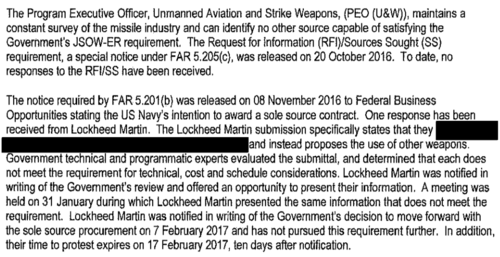
Last edited:
- Joined
- 3 June 2011
- Messages
- 18,337
- Reaction score
- 12,239
If the former, what's wrong with competing JSM and JSOW-ER?
You mean aside from the fact they're slow as molasses running off an iceberg and relatively short ranged?
" The US Air Force, in a recent RFI, is looking for a maritime strike weapon that could be an alternative to making a longer-range version of the LRASM, according to an expert. (Getty Images) "
How does using a weapon with LESS range than LRASM as an alternate to making a weapon with MORE range than LRASM make sense?
- Joined
- 16 April 2008
- Messages
- 9,605
- Reaction score
- 14,501
If the former, what's wrong with competing JSM and JSOW-ER?
You mean aside from the fact they're slow as molasses running off an iceberg and relatively short ranged?
" The US Air Force, in a recent RFI, is looking for a maritime strike weapon that could be an alternative to making a longer-range version of the LRASM, according to an expert. (Getty Images) "
How does using a weapon with LESS range than LRASM as an alternate to making a weapon with MORE range than LRASM make sense?
Fair. I missed the longer range aspect.
Of course, at long range who cares about internal carriage? A JSF or F-15 could hange a couple externally and launch well outside any likely defensive perimeter.
marauder2048
"I should really just relax"
- Joined
- 19 November 2013
- Messages
- 3,157
- Reaction score
- 926
If the former, what's wrong with competing JSM and JSOW-ER?
You mean aside from the fact they're slow as molasses running off an iceberg and relatively short ranged?
" The US Air Force, in a recent RFI, is looking for a maritime strike weapon that could be an alternative to making a longer-range version of the LRASM, according to an expert. (Getty Images) "
How does using a weapon with LESS range than LRASM as an alternate to making a weapon with MORE range than LRASM make sense?
Fair. I missed the longer range aspect.
Of course, at long range who cares about internal carriage? A JSF or F-15 could hange a couple externally and launch well outside any likely defensive perimeter.
IIR-based weapons are going to be somewhat dependent on in-flight target updates to find fast moving surface combatants in all weather.
If the launching aircraft is providing those updates from 200+ nm out that's really beyond the practical ISAR range
for fighter-band radars against surface combatants with any signature reduction.
If we're specifically talking about the F-35, which seems to be the case, it looks like they are concerned with internal carriage. Though it isn't clear to me why JSM would not be a solution. I'd think SiAW would also be an easy candidate given the short flight time; the USN has already done testing with AGM-88E that indicate it could be effective in targeting ships, though the warhead is sub optimal. JSOW-ER is the worst of both worlds in terms of engaging a well defended target; it isn't a sea skimmer nor is it fast.
marauder2048
"I should really just relax"
- Joined
- 19 November 2013
- Messages
- 3,157
- Reaction score
- 926
If we're specifically talking about the F-35, which seems to be the case, it looks like they are concerned with internal carriage. Though it isn't clear to me why JSM would not be a solution. I'd think SiAW would also be an easy candidate given the short flight time; the USN has already done testing with AGM-88E that indicate it could be effective in targeting ships, though the warhead is sub optimal. JSOW-ER is the worst of both worlds in terms of engaging a well defended target; it isn't a sea skimmer nor is it fast.
They all have tiny warheads by LRASM or other ASCM standards. JSM has Penguin's warhead.
JSOW-ER is likely going to be cut down to ~ 300 lbs to make way for the fuel tank.
- Joined
- 16 April 2008
- Messages
- 9,605
- Reaction score
- 14,501
JSM has Penguin's warhead.
Not unless Penguin got a titanium-cased warhead with a void-sensing fuse somewhere along the way. Raytheon even calls it a 500-pound class warhead, but I think they're messing about with something to get that number. (Possibly fill weight compared to a Mk-82?)
marauder2048
"I should really just relax"
- Joined
- 19 November 2013
- Messages
- 3,157
- Reaction score
- 926
JSM has Penguin's warhead.
Not unless Penguin got a titanium-cased warhead with a void-sensing fuse somewhere along the way. Raytheon even calls it a 500-pound class warhead, but I think they're messing about with something to get that number. (Possibly fill weight compared to a Mk-82?)
It's exactly the same weight as Penguins. 264 lbs. I'm sure they've played with the case material and fuze.
But the HE fill (along with HE to case material ratio) is the main driver for damage modes.
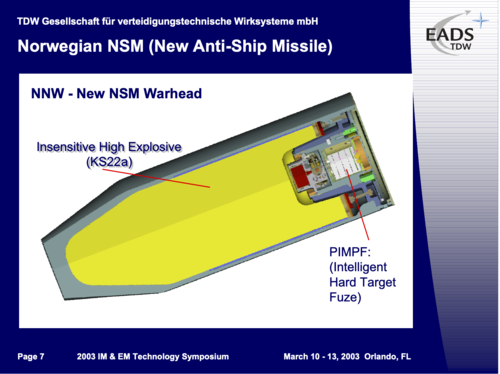
Last edited:
The original wording was in that way: "A 500-lbs-warhead-like EFFECT". Based on lighter titanium shell of warhead and better explosive filling. Most probably refering to a Mk82 bomb warhead for reference. Weight was given (depending on source) as 120kg, 125kg, 130kg, 250lbs and 264lbs.

